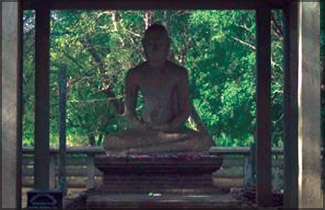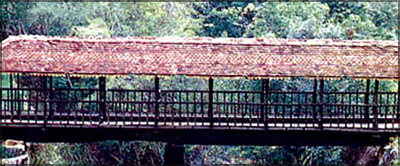 The
Samadhi Buddha statue The
Samadhi Buddha statue
Samadhi is a state of
inner spiritual union with the object of observation. This is one of the
ultimate stages of Buddhist spiritual practice.
Anyone visiting Anuradhapura will not miss to visit and place flowers
at the base of the beautiful 5th century Samadhi Buddha statue, situated amongst the widespread remains
of the ancient religious city of Anuradhapura.
century Samadhi Buddha statue, situated amongst the widespread remains
of the ancient religious city of Anuradhapura.
This Pilima Vahanse is said to belong to the Abeygiriya period of the
3rd or 4th century of the country's history. It is not known in whose
period of rule it was sculptured but is believed to be one of four
similar statues facing the North, South, East and West found in this
area. This statue faces the North.
The statue was found in 1888, with the nose damaged, at the very site
it is now in. According to archaeologists, after the nose was repaired,
it was over shaped and oversized. It may be because an ordinary mason
who had no idea of proportions or aesthetics carried out the repair
work.
The statue is 7'3 inches in height, and is carved from a single
granite rock. It is said to have had two jewels for the eyes which are
to said to have gone missing around 1914. The reality of this is
questionable as the eyes are closed with no place for jewels to be
placed. The shelter over the statue was constructed in 1959 or 1960.
According to these sources, Jawaharlal Nehru admired it when he first
saw the statue in 1931. A year later, when he was in the Dehra Dun, a
friend of his from Sri Lanka, then Ceylon, had sent him a picture of
this statue which he had even kept with him in his cell; it had become
his precious companion.
The Samadhi statue is symbolic of the peace and happiness of mind,
with no attraction or hatred from the outside world to disturb it.
****
The roofed bridge of Bogoda
Have you ever visited the fascinating
bridge of Bogoda?
Bogoda, with its ancient temple and wooden bridge lies about 30 km
from Bandarawela and 10 km from Badulla, off the Hali-ela junction.
Believed to be the oldest surviving wooden bridge in the world, the
Bogoda bridge dates back to the 1600s, but the temple just by it, has a
much longer history, going back to the 1st century BC.
 The
Bridge belongs to the Dambadeni Era. The special feature of this is that
it is made entirely out of wood and is full of woodcarvings. According
to the legend, not a single steel nail has been used in the construction
of the bridge. This bridge is around 50 feet in length and about five
feet wide. The
Bridge belongs to the Dambadeni Era. The special feature of this is that
it is made entirely out of wood and is full of woodcarvings. According
to the legend, not a single steel nail has been used in the construction
of the bridge. This bridge is around 50 feet in length and about five
feet wide.
The roof has distinctly Kandyan style tiles and even the modest
decorative carvings on the wooden pillars holding up the roof belongs to
that era. The roof over the bridge is for shelter and protection from
bad weather.
The bridge had been also used as an ambalama during the old days when
travelling took weeks of hard walking. This bridge is believed to have
been built by a father and son who were wood craftsmen.
According to the folk stories, the son was assigned with the task of
completing the bridge and was told not to leave the place until the
father came to add the final touches.
The son who was too impatient to wait for his father, having
completed part of the task, went to meet the father disobeying orders.
Since the ritual finishing touches were not done before the son left
the site, he was cursed, and died prematurely. The bridge built across
the Gallanda Oya, as it flows down the mountain to meet Uma Oya in Uva
Paranagama (a branch of the Mahaweli Ganga), is on an ancient route,
which linked Badulla and Kandy. When you cross the bridge, you can reach
the village of Mahakumbura and the route then leads to Uva Ketawela.
The bridge is still the road used by many villagers around.
Janani Amarasekara |
